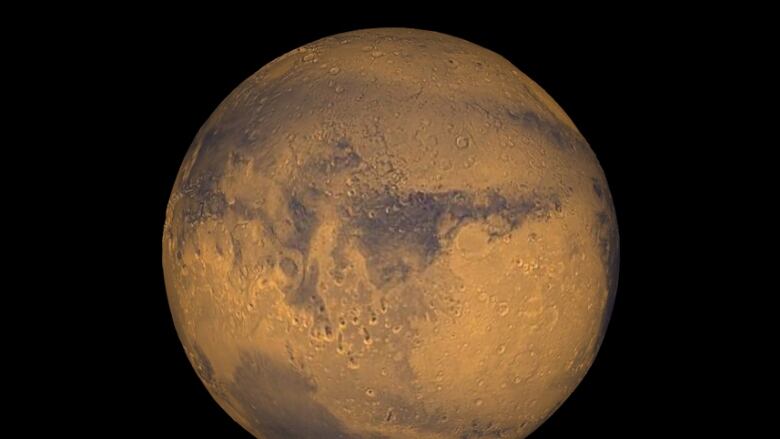Mars will be brighter and more visible this week than it has been in a decade, says astronomer
Using a telescope, Red Planet details such as volcanoes will be discernible

Alberta's night sky will be extra pretty this week.
After sunset, Mars will be shining the brightest it has in well over a decade.
The Red Planet will be rising in the eastern horizon, and CBCCalgary's stargazer, DonHladiuk,says it's oneof the closest encounters we've had in awhile.
"We will not be this close to Mars until 2035, so it's a wonderful time to go out," hetold theCalgary Eyeopener.
On Tuesday, the Earth will be 62.7 million kilometres away, which in light time is about 3 minutes, he says.
Despite the close proximity,the planetwillstill appear to be a small, but Hladiuksays it will be very bright to the unaided eye.
"In fact, it's brighter than the largest planet in our solar system, Jupiter, right now, for the next few days," he said.
As well, those with telescopeswillbe able to make out certain details on the planet, saidElaina Hyde, astronomer and assistant professor at York University.
"It's going to be a lot better for observing, a lot better to look at through telescopes, like our one-metre telescope on campus, and it will be very, very fun to watch at night just with your naked eye," she said.
It's set to fully align on Oct. 13, when various details on the surface of the red planet, such as the southern polar cap and volcanoes, will be visible.
And if you want a really good view, there will bea broadcast of the planet available online.
The Allan I. Carswell Observatory in Torontohas set up a live event where it will broadcast real-time images through its one-metre telescope to anyonesitting at home to look at the planet through a virtual lens.
The event will be broadcaston itsYouTube channel on Tuesday and again Oct. 11-15, from 8 p.m. to 10 p.m. EST, as long as the weather is clear.
The broadcast has also been embedded below and can be watched here.
"The fun thing about that is, of course, Mars rotates," said Hyde. "It has a day just like Earth does, and because we're at an angle, on different days and times, we'll actually be able to catch different features, sort of as they go by with our relative positions."
"Don't sleep on this one," she said. "You don't want to have to wait a whole 15 years to catch it this good."
More noteworthy space events
Hladiuksays another date you should circle in your calendar is Oct.21 since it will be peak meteor watching time.
"If you can get up early in the morningwe're going to be reaching the peak of the Orionids meteor shower."
As well, at the end of the month, there will be anotherfull moon, which usually isn't a big deal but this time it falls on Oct. 31.
"Because it's the second one in the month, we're going to call it a blue moon. And blue moons are not that rare. Maybe two every two, three years, but this one falls on Halloween,"Hladiuk said.
"Last one was about 2001, and the next one's not until like 2039, so all those Halloweeners have a very special evening to go out and watch the spooky, blue moon."
With files from Jessica Cheung, Ania Bessonov and the Calgary Eyeopener.












_(720p).jpg)


 OFFICIAL HD MUSIC VIDEO.jpg)
.jpg)



























































































